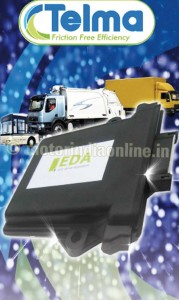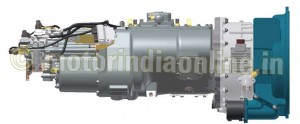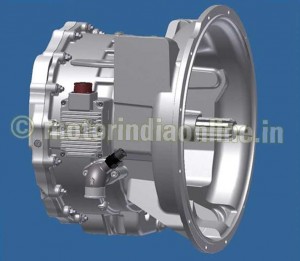Telma Retarders India Pvt. Ltd. (TRIPL), the Indian subsidiary of Telma SA, the global leaders in electromagnetic retarders, has registered considerable growth in the current financial year despite general industrial slowdown.
“Volvo’s Asia bus range and the rear engine bus range from Ashok Leyland with Telma retarders are gaining market acceptance, and the expected spurt in demand in 2014 will hopefully translate into big orders for TRIPL. This has been reinforced with the orders generated during the ongoing project discussions with the leading vehicle OEMs”, says Mr. Sriram, Managing Director, TRIPL. Concurrently, TRIPL is actively attempting parts localisation in order to further drive down its cost and time to market, thus enhancing its support for the customers.
the expected spurt in demand in 2014 will hopefully translate into big orders for TRIPL. This has been reinforced with the orders generated during the ongoing project discussions with the leading vehicle OEMs”, says Mr. Sriram, Managing Director, TRIPL. Concurrently, TRIPL is actively attempting parts localisation in order to further drive down its cost and time to market, thus enhancing its support for the customers.
“Telma, leveraging on its 60-year experience, is on the ambitious path of partnering with leading CV OEMs by integrating our Torque Input Retarders (TIRs) at the early stages of vehicle development itself, thus creating a virtual revolution in the commercial vehicle braking technology”, says Mr. Jan Bor, CEO, Telma Global.
The new-age retarder
 Since inception, Telma has significantly contributed to road safety by manufacturing induction braking systems that include more than 250 variations of electric retarders with torque ranging from 350 Nm to 3000 Nm. Globally, Telma is recognized through its collaborations with eminent component OEMs like ZF, Eaton, Fast Gear, Allison, Meritor, etc. In India the integration has already been made with leading manufacturers, including Ashok Leyland, SML Isuzu, Daimler and AMW.
Since inception, Telma has significantly contributed to road safety by manufacturing induction braking systems that include more than 250 variations of electric retarders with torque ranging from 350 Nm to 3000 Nm. Globally, Telma is recognized through its collaborations with eminent component OEMs like ZF, Eaton, Fast Gear, Allison, Meritor, etc. In India the integration has already been made with leading manufacturers, including Ashok Leyland, SML Isuzu, Daimler and AMW.
One of the latest products of Telma, the new-age retarder of TIR provides smart and complete solution for safety braking systems for  the emerging market. TIR incorporates a compact design with high power density in each transmission gear and at each vehicle speed without a drop in torque. This friction-free braking system has modularity in design for a wide variety of brake performance ranges from 900 Nm to 3300 Nm.
the emerging market. TIR incorporates a compact design with high power density in each transmission gear and at each vehicle speed without a drop in torque. This friction-free braking system has modularity in design for a wide variety of brake performance ranges from 900 Nm to 3300 Nm.
The future role of safety as a motivating factor in retarder purchase is expected to remain significant. The continuing decline in vehicle rolling resistance will place even greater demand on braking system. It is expected that this increase in braking requirements will result in growing demand for retarders. The economic advantage of retarder installation on the basis of brake life extension is determined by the return on investment (ROI) which seems to project substantial result. Apart from bringing about improved vehicle safety, brake life, tire life and fuel economy, “Telma’s Torque input Retarder (TIR) is a huge leap from the basic brake function to complete brake-system integration. Telma is set to assist vehicle OEMs in achieving vertical integration by designing, developing and manufacturing TIR in line with their requirements. High level of quality is underpinned by this vertical integration, which allows for control at every step of design and also helps companies to reduce cost and improve efficiency”, says Mr. G. Prakash Gopi, TRIPL AGM.
The TIR comes with an Integrated Electronic control (TiRec) with 12- 24V and Controller Area Network CANBus capability and vehicle brake-system Integration. The other unique feature of TIR is that it weighs much less (78 kg) compared to other electric retarders (above 100 kg). The TIR consumes less power of about 50A and the provision for electronic communication with the ABS and EBS resulting in the instantaneous ON & OFF response time less than two seconds.
New-age TIR has the potential to produce maximum torque even at low speed of 3 km/hour similar to all the existing retarders. Unlike the hydraulic retarder, Telma’s TIR contributes very low drag-loss, and the induced eddy current in the rotor which produces the opposing magnetic field in the stator incorporates its own integrated cooling system (water cooled).
Eco-Drive Assistance
Telma, pacing steadily on the path of superior innovations in vehicle technology, remains vigilant about new technologies and emerging market needs. This has led to the electromagnetic retarder giant taking up the dealership for distribution of the Eco-drive Assistance systems (EDA).
Telma’s EDA, designed in Germany and made in Austria, assists the vehicle to “eco drive” by measuring the engine speed and RPM, thereby facilitating optimum running condition for the vehicle. EDA, a CE certified and EMC-approved product, is exclusively distributed by the retarder specialist Telma.
“In the automotive industry, energy is wasted during inefficient acceleration/deceleration, poor anticipation, congestion, wrong gear and engine speed. The EDA recognizes the vehicle load, driver rhythm and acceleration cycles by helping the engine RPM to operate in an optimized running condition zone called the ‘Green Zone’ that in turn leads to reduction in fuel consumption by around 5-12 per cent. The EDA rewrites the throttle command, restricting the acceleration power at low speeds from 10-40 km/hour”, says Mr. Andre Ruger, Business Development.
EDA is installed between an engine control unit (ECU) and electronic throttle. An ECU uses the closed-loop control that monitors the output of a system in order to regulate the input to the system. It helps the vehicle to keep track and manage emissions, fuel economy and a host of other parameters, including transmission efficiency, vehicle speed, rate of acceleration, etc.
The benefit from EDA installation is that it does not require a Controller Area Network-CANBUS, a serial bus protocol to connect individual systems and sensors. This unique advantage makes EDA perform quicker without any protocol inference.
The application of EDA will make a positive impact on the gear and speed choices of the driver as well as accelerating and decelerating behaviors. Besides the significant reduction in fuel consumption, the other major advantage is that EDA provides a maintenance-free product with less CO2 emissions. Driver training is not required. The system, including speed and/or RPM limiter is also available. The EDA is most suited for transportation mode which involves frequent stop/start cycles and can be integrated independent of the vehicle type, brand and application size.
The EDA technology has become highly popular, with over 1,000 units operating successfully in and around Europe. The feedback has been very positive on usefulness and environmental impact.